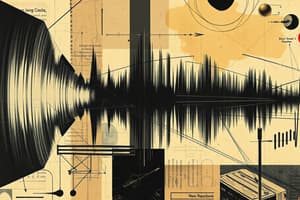Podcast
Questions and Answers
What do compressions in a sound wave represent?
What do compressions in a sound wave represent?
- Regions of maximum pressure and density (correct)
- Regions of low pressure
- Areas where particles are spread apart
- Segments of low density
What is the correct representation of wavelength in symbols?
What is the correct representation of wavelength in symbols?
- m (metre)
- ν (nu)
- λ (lambda) (correct)
- Hz (hertz)
What is the time period of a wave defined as?
What is the time period of a wave defined as?
- The number of oscillations per unit time
- The density of the medium during oscillation
- The duration of one complete oscillation (correct)
- The distance between two compressions
What property of sound is primarily associated with loudness?
What property of sound is primarily associated with loudness?
Which of the following correctly describes rarefactions?
Which of the following correctly describes rarefactions?
Which sound is likely to have a higher pitch?
Which sound is likely to have a higher pitch?
H.R. Hertz is known for which of the following discoveries?
H.R. Hertz is known for which of the following discoveries?
What SI unit is used to measure frequency?
What SI unit is used to measure frequency?
How is the speed of a sound wave calculated?
How is the speed of a sound wave calculated?
What term describes the sound produced by a mixture of several frequencies?
What term describes the sound produced by a mixture of several frequencies?
What does the peak of a wave signify?
What does the peak of a wave signify?
If a sound wave has a frequency of 2 kHz and a wavelength of 35 cm, what is its speed?
If a sound wave has a frequency of 2 kHz and a wavelength of 35 cm, what is its speed?
How can frequency be determined in sound waves?
How can frequency be determined in sound waves?
Which type of sound is considered unpleasant to the ear?
Which type of sound is considered unpleasant to the ear?
If sound takes 2.1 seconds to travel a certain distance, what distance did it cover if the speed of sound is 700 m/s?
If sound takes 2.1 seconds to travel a certain distance, what distance did it cover if the speed of sound is 700 m/s?
What is the relationship between wavelength and frequency in a sound wave?
What is the relationship between wavelength and frequency in a sound wave?
What is the minimum time interval required to hear a distinct echo?
What is the minimum time interval required to hear a distinct echo?
Which material has the lowest speed of sound among the listed options?
Which material has the lowest speed of sound among the listed options?
What speed of sound is attributed to distilled water?
What speed of sound is attributed to distilled water?
If the speed of sound is 346 m s–1 and the time taken for an echo is 2 s, what is the distance to the reflecting surface?
If the speed of sound is 346 m s–1 and the time taken for an echo is 2 s, what is the distance to the reflecting surface?
Which of the following substances has a speed of sound greater than that of ethanol?
Which of the following substances has a speed of sound greater than that of ethanol?
What happens when you lift a pipe vertically while observing sound behavior?
What happens when you lift a pipe vertically while observing sound behavior?
Which gas has the lowest speed of sound according to the given data?
Which gas has the lowest speed of sound according to the given data?
If a person hears an echo, what does this indicate about the distance to the reflecting object?
If a person hears an echo, what does this indicate about the distance to the reflecting object?
What creates sound in the human voice?
What creates sound in the human voice?
Which medium is most commonly associated with the travel of sound?
Which medium is most commonly associated with the travel of sound?
What materials are typically used to reduce reverberation in an auditorium?
What materials are typically used to reduce reverberation in an auditorium?
When a vibrating object moves forward, it creates which region in the medium?
When a vibrating object moves forward, it creates which region in the medium?
What is produced when a stretched rubber band is plucked?
What is produced when a stretched rubber band is plucked?
Why are the ceilings of concert halls usually curved?
Why are the ceilings of concert halls usually curved?
What is the primary function of a stethoscope?
What is the primary function of a stethoscope?
What are compressions and rarefactions associated with?
What are compressions and rarefactions associated with?
What sound frequency range is generally considered audible for humans?
What sound frequency range is generally considered audible for humans?
Which statement accurately describes rarefaction?
Which statement accurately describes rarefaction?
What happens to particles of the medium when sound is produced?
What happens to particles of the medium when sound is produced?
What is infrasound?
What is infrasound?
How does sound propagate through different media?
How does sound propagate through different media?
How does sound travel within a stethoscope?
How does sound travel within a stethoscope?
Which age group can typically hear frequencies up to 25 kHz?
Which age group can typically hear frequencies up to 25 kHz?
What role does a soundboard play in a hall?
What role does a soundboard play in a hall?
What is the primary purpose of using ultrasonic waves in metal inspection?
What is the primary purpose of using ultrasonic waves in metal inspection?
How do hearing aids function to assist individuals with hearing loss?
How do hearing aids function to assist individuals with hearing loss?
What effect do cracks and holes inside metal blocks have on structural integrity?
What effect do cracks and holes inside metal blocks have on structural integrity?
What type of waves do rats use to communicate during their games?
What type of waves do rats use to communicate during their games?
In ultrasonic inspection, what happens when sound waves encounter a change in tissue density?
In ultrasonic inspection, what happens when sound waves encounter a change in tissue density?
Which component is NOT part of the hearing aid's signal processing system?
Which component is NOT part of the hearing aid's signal processing system?
What is the role of the detector in ultrasonic testing of metals?
What is the role of the detector in ultrasonic testing of metals?
Which of the following structures typically uses metallic components?
Which of the following structures typically uses metallic components?
Flashcards
Sound Propagation
Sound Propagation
The process by which sound travels through a medium.
Compressions
Compressions
Regions of high pressure created by the vibrating object pushing air particles together.
Rarefactions
Rarefactions
Regions of low pressure created by the vibrating object pulling air particles apart.
Medium
Medium
Signup and view all the flashcards
Vibrating Objects
Vibrating Objects
Signup and view all the flashcards
Pressure
Pressure
Signup and view all the flashcards
Vibration
Vibration
Signup and view all the flashcards
How Sound Propagates
How Sound Propagates
Signup and view all the flashcards
Wavelength
Wavelength
Signup and view all the flashcards
Frequency
Frequency
Signup and view all the flashcards
Oscillation
Oscillation
Signup and view all the flashcards
Time Period
Time Period
Signup and view all the flashcards
Hertz (Hz)
Hertz (Hz)
Signup and view all the flashcards
Refraction
Refraction
Signup and view all the flashcards
Pitch
Pitch
Signup and view all the flashcards
Loudness
Loudness
Signup and view all the flashcards
Tone
Tone
Signup and view all the flashcards
Note
Note
Signup and view all the flashcards
Noise
Noise
Signup and view all the flashcards
Echo
Echo
Signup and view all the flashcards
Echo Time
Echo Time
Signup and view all the flashcards
Distance to Reflecting Surface
Distance to Reflecting Surface
Signup and view all the flashcards
Speed of Sound
Speed of Sound
Signup and view all the flashcards
Angle of Incidence
Angle of Incidence
Signup and view all the flashcards
Angle of Reflection
Angle of Reflection
Signup and view all the flashcards
Law of Reflection for Sound
Law of Reflection for Sound
Signup and view all the flashcards
Refraction of Sound
Refraction of Sound
Signup and view all the flashcards
Reducing Reverberation
Reducing Reverberation
Signup and view all the flashcards
How Megaphones and Horns Work
How Megaphones and Horns Work
Signup and view all the flashcards
Stethoscope: Amplifying Sound
Stethoscope: Amplifying Sound
Signup and view all the flashcards
Curved ceilings in Concert Halls
Curved ceilings in Concert Halls
Signup and view all the flashcards
Soundboards in Concert Halls
Soundboards in Concert Halls
Signup and view all the flashcards
Human Hearing Range
Human Hearing Range
Signup and view all the flashcards
Infrasound
Infrasound
Signup and view all the flashcards
Ultrasound
Ultrasound
Signup and view all the flashcards
Ultrasonic Echolocation
Ultrasonic Echolocation
Signup and view all the flashcards
Ultrasonic Testing
Ultrasonic Testing
Signup and view all the flashcards
Compressions in Sound Waves
Compressions in Sound Waves
Signup and view all the flashcards
Rarefactions in Sound Waves
Rarefactions in Sound Waves
Signup and view all the flashcards
Medium for Sound Propagation
Medium for Sound Propagation
Signup and view all the flashcards
Hearing Aid
Hearing Aid
Signup and view all the flashcards
Importance of Metal Components in Construction
Importance of Metal Components in Construction
Signup and view all the flashcards
Impact of Flaws in Metal Blocks for Construction
Impact of Flaws in Metal Blocks for Construction
Signup and view all the flashcards
Study Notes
Sound
- Sound is a form of energy that produces a sensation of hearing.
- Sound is produced by vibrating objects.
- Sound can be produced without using energy by changing forms of energy from one to another.
- The conservation of energy principle states that energy cannot be created or destroyed, only changed from one form to another.
Production of Sound
- Tuning forks vibrate when a prong touches a rubber pad, or a table tennis ball hanging by a thread, to make a sound.
- Vibrating objects produce sound, like a vibrating tuning fork, vocal cords, wings, etc
- Rapid to and fro motion of objects is called vibration.
- Plucking, scratching, rubbing, blowing or shaking different objects cause them to vibrate and produce sound.
Propagation of Sound
- Sound travels through a medium (solid, liquid, or gas) by vibrations from the source to a listener.
- The particles of the medium vibrate and pass on the sound vibration to other particles.
- Sound waves are longitudinal; particles vibrate parallel to the direction of the wave.
- An object vibrating creates compressions (high pressure) and rarefactions (low pressure); this creates a wave.
Characteristics of a Sound Wave
- Frequency: Number of vibrations per second, measured in Hertz (Hz); Higher frequency corresponds to higher pitch.
- Amplitude: Maximum displacement from the mean position; Higher amplitude means louder sound.
- Wavelength: Distance between two consecutive compressions or rarefactions.
- Speed: The rate at which the sound wave travels through a medium. Speed depends on the medium.
Speed of Sound in Different Media
- Sound travels faster in solids than liquids, and faster in liquids than gases.
- The speed of sound depends on the temperature of the medium. Higher temperature generally results in a faster speed.
Reflection of Sound
- Sound reflects off a solid or liquid surface.
- The angle of incidence equals the angle of reflection.
- Echoes are repeated reflections of sound, requiring a minimum distance for reflection to be perceptible. -Reverberation is the persistence of sound in a large hall due to repeated reflections.
Range of Hearing
- Humans typically hear frequencies from 20 Hz to 20,000 Hz.
- Frequencies below 20 Hz are infrasonic; above 20,000 Hz are ultrasonic.
- Animals can hear frequencies outside this range.
Uses of Ultrasound
- Cleaning delicate objects or parts in industry
- Detecting flaws or cracks in metal objects
- Medical imaging (e.g., echocardiography)
Studying That Suits You
Use AI to generate personalized quizzes and flashcards to suit your learning preferences.



